Informational
MIG vs Flux Core Welding: Understanding the Key Differences
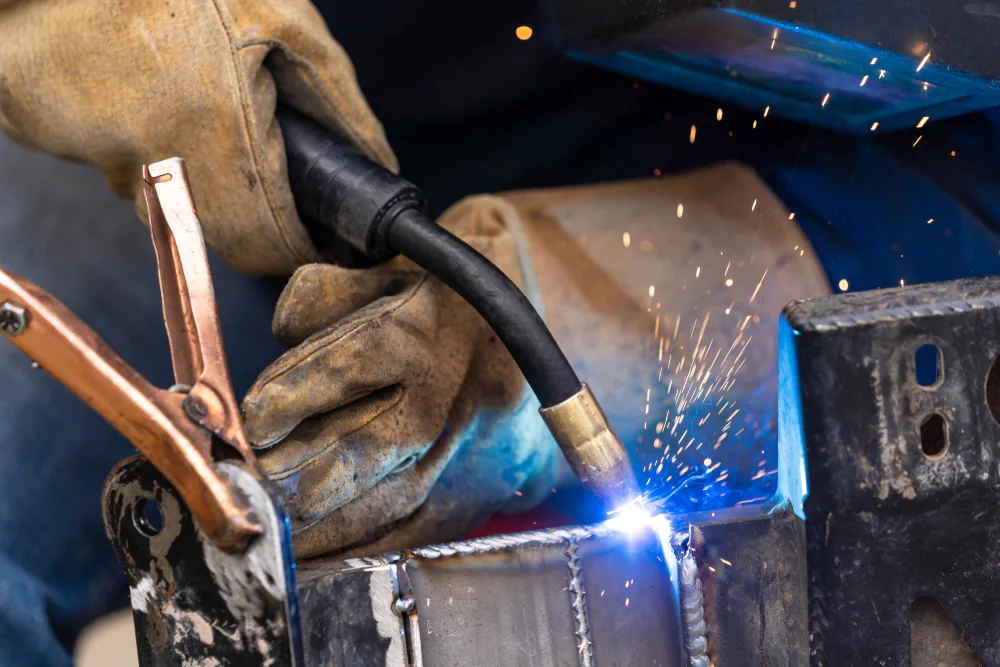
MIG and flux core welding are two popular welding methods that are used for various metal fabrication and repair projects. Both of these methods use a wire welding electrode to create an electric arc that melts the wire and fuses it with the base metal.
But still there are some key differences between MIG and flux core welding that you need to understand before starting your project. In this blog I will break down the main differences between MIG and flux core welding and help you understand which method is best for your specific needs.
MIG welding uses a continuously fed wire electrode and a shielding gas to protect the weld pool from the atmosphere. On the other hand, Flux cored arc welding uses a continuously fed flux core electrode wire that vaporizes and forms a gaseous cloud which protects the surface of the weld. In simple words, MIG welding uses a shielding gas while Flux cored welding uses a flux core to protect the weld.
| Property | MIG | Flux Core |
|---|---|---|
| Speed | ? Fast | ? Moderate |
| Ease of use | ? Easy | ? Moderate |
| Operating cost | ? Moderate | ? Low |
| Equipment cost | ? High | ? Low |
| Thickness weldability | ? Wide range | ? Limited |
| Strength | ? Strong | ? Moderate |
| Safety | ? Good | ? Moderate |
| Cleanup | ? Almost zero | ? Moderate |
| Shielding method | ? Shielding gas | ? Flux |
| Outdoor welding | ? Difficult | ? Easy |
| Portability | ? Moderate | ? High |
| Automation | ? Possible | ? Limited |
MIG Welding
MIG welding, also known as Gas Metal Arc Welding (GMAW), is a type of welding that uses a continuously fed supply of electrode wire and a shielding gas to protect the weld pool from the atmosphere.
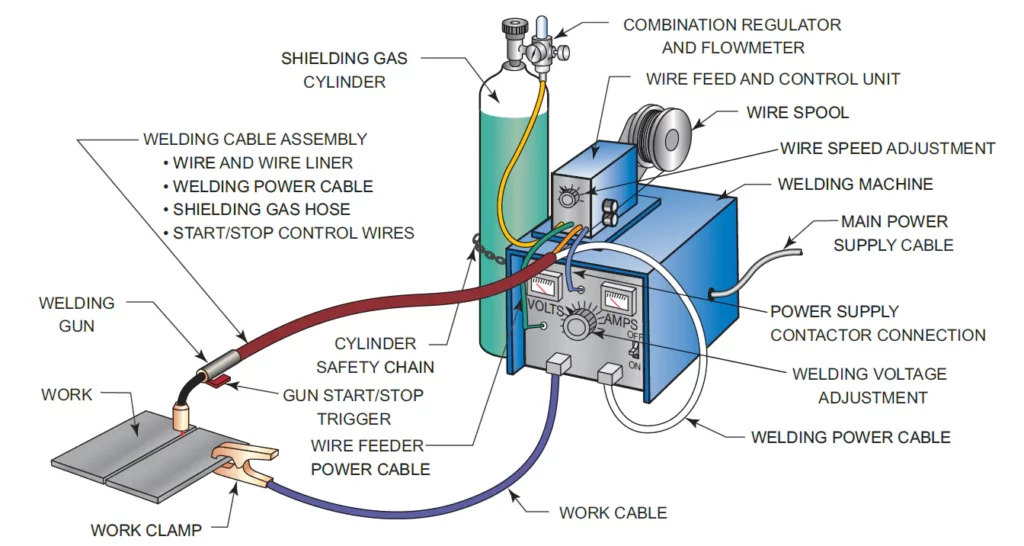
The electrode wire is fed into a MIG welding machine, which directs it down into a gun. The gun then melts the electrode and deposits it on the parent metal to make a weld.
The gun also directs a shielding gas flow (usually argon) over the weld pool. MIG welding machines can use different types of metal transfer, such as short circuit, spray arc, pulse, and globular transfer, depending on the type of metal and the desired outcome of the weld.
Useful: Robotic MIG welding is also possible, which completely automates the welding process.
Advantages of MIG Welding
Here are few of the advantages that MIG welding offers:
1. It’s Fast
One of the main advantages of MIG welding is its speed. With a continuously fed electrode, MIG welding can outpace other welding processes under identical conditions. This makes MIG welding an ideal choice for large-scale projects or tight deadlines.
2. Ease of Use
Another advantage of MIG welding is its ease of use. Several of the processes that take place during a MIG weld are automated, which makes it easier to pick up and succeed with quickly than other types of welding such as TIG welding.
3. Works with Wide Range of Thicknesses
MIG welding also works on metals in a wide range of thicknesses. MIG allows you to achieve good penetration (weld depth) and still produce a smooth, strong weld bead. The amount of current you use determines the penetration you can achieve with MIG welding.
4. Almost Zero Cleanup Time
MIG welding also eliminates almost all need for cleanup time. Unlike stick welding, MIG welding doesn’t involve flux or create much slag (debris). This means that less time is spent on post-weld cleaning, saving you time and money.
5. Reduced Number of Starts and Stops
MIG welding also cuts down on the number of starts and stops. With a continuously fed electrode, it helps to limit the number of times that you have to stop welding, adjust or get a new electrode, and then start welding again.
It may not seem like a lot, but when you think about how much time you can lose stopping and starting over the course of a project (or a career!), it can really add up.
6. Eliminates Stub Loss
Another advantage of MIG welding is that it eliminates electrode stub loss. With stick welding, the last few inches of an electrode cannot be used. But with MIG welding, you can use the whole electrode, this eliminates the wastage of electrode and reduces the cost.
7. Single Weld Large Passes
MIG welding also allows for larger passes with a single weld. These longer passes are another reason that MIG is faster than other welding processes. With MIG welding, you can deposit more metal with each pass, which means you can get away with fewer passes when working on a big joint.
The width of the MIG weld pool is determined by the speed of travel (how fast you’re welding), this allows you to make better control over the width of the weld.
Limitations of MIG Welding
MIG welding is not without its limitations. Here are some of the key limitations of MIG welding:
1. Costly Equipment
One of the main limitations of MIG welding is its cost. MIG equipment, particularly the machine, is quite a bit more complex than what you use for stick welding and it costs more to manufacture.
This increased manufacturing cost is passed on to the user, making MIG equipment costly compared to stick welding equipment.
2. Difficult to Weld Outside
MIG welding outside is difficult because it requires a shielding gas. Any kind of breeze can disrupt your ability to MIG weld effectively.
You can accomplish MIG welding outside, but it has to be a very still day (no wind), or you have to use a really good windscreen if you’re going to be successful.
MIG welding equipment is also not very portable, so getting it in and out of your shop on a regular basis may be problematic.
If you’re looking for maximum portability, you may want to look to another type of welding.
3. Large Welding Guns
MIG guns are also relatively large. A MIG welding gun has a lot going on inside, and as a result, it’s a bulkier piece of equipment than what you may expect to use for, say, stick welding. This limitation may make manipulating a MIG welding gun in a tight space difficult.
4. Equipment Requires More Maintenance
MIG equipment also requires more maintenance than other types of welding equipment. This usually means more downtime (while you’re adjusting your equipment or waiting for the guys at the welding shop to fix it) and more cost.
Materials Suitable for MIG Welding
MIG welding is suitable for a wide range of materials including
1- Carbon Steel: It is the most commonly used material for MIG welding. Its strong, durable and versatile material that is used in a wide range of applications.
2- Stainless Steel: Stainless Steel is popular choice for Mig welding due to its corrosion resistance and high strength. Its often used in the food industry, medical equipment and marine applications.
3- Aluminum: MIG welding is popular method for welding aluminum as well. Due to its ability to produce high quality welds with minimal distortion. Its commonly used in aerospace and automotive industry.
4- Magnesium: Magnesium is a lightweight and strong material that is used in wide range of applications. MIG welding is also suitable for welding magnesium as it produces high quality welds and minimal distortion.
5- Copper: Copper is popular choice for MIG welding in the electrical industry due to its good electrical and thermal conductivity.
6- Nickel: Nickel is corrosion resistant and heat resistant material that is commonly used in the aerospace and chemical industries. You can also MIG weld Nickel as well.
7- Silicon Bronze: Silicon bronze is a popular choice for MIG welding in the marine industry due to its corrosion resistance and high strength.
Equipment Needed for MIG Welding
The equipment needed for MIG welding includes:
1- Power Supply: converts AC to DC and allows for adjusting voltage, polarity, and wire feed rate.
2- Wire Feed Unit: consists of a drive motor, drive rolls, spool adapter, and spool of electrode.
3- Torch/Gun: attached to the power supply and includes a power control switch, liner for filler metal, and liner for shielding gas. A spool gun may be used for aluminum wire.
4- Work Cable/Work Clamp: attaches to the work piece to complete the circuit.
5- Electrodes: various types available for different compositions, metal cleanliness, and shielding gas. Examples include ER70S-6 for mild steel and specific types for aluminum.
6- Shielding Gas: protects the weld pool from contamination by the atmosphere. Different types of shielding gas are used depending on the type of welding and the metal being welded. Common types include argon, helium, and carbon dioxide.
7- Gas Regulator: controls the flow of shielding gas to the torch.
8- Ground Clamp: attaches to the work piece to complete the circuit and provide a ground for the welding current.
Flux-Core Welding (FCAW)
Flux cored arc welding (FCAW) is a welding process that uses a continuously fed flux core electrode wire and welding power that flows through a cable assembly and out through a gun. The flux core vaporizes and forms a gaseous cloud that protects the surface of the weld.
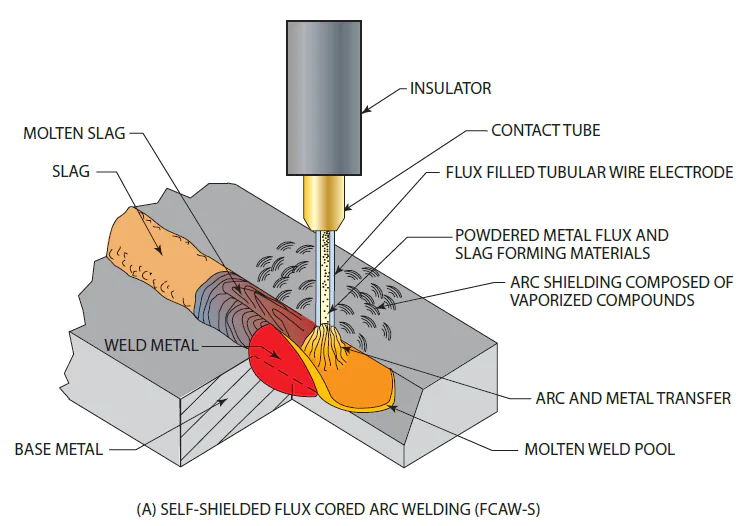
The flux also gathers impurities and floats them to the surface where it forms a slag covering on the weld as it cools. FCAW is a high quality, versatile, and fast welding process that is popular among welding fabricators.
It is a semiautomatic process where the filler metal is automatically fed into the welding arc, and the welder manually moves the welding gun along the joint being welded.
FCAW equipment and filler metals are widely available at welding supply, hardware, building supply, and automotive supply stores.
Advantages of Flux-Core Welding
Flux Cored Arc Welding (FCAW) is a popular welding method in the industry due to the many advantages it offers.
1. High Deposition Rate
One of the main advantages of FCAW is its high deposition rate. With FCAW, it is possible to deposit weld metal at rates of more than 25 lb/hr, which is significantly higher than the rates possible with other welding methods such as SMAW.
2. Minimum Electrode Waste
FCAW is its efficient use of filler metal. The FCA method makes use of between 75% and 90% of the weight of the FCAW electrode, which is more than the 75% maximum filler metal used in SMAW electrodes.
Moreover, FCA welding has no stub loss, meaning nearly 100% of the FCAW electrode purchased is consumed.
3. Narrow Groove Angle
FCAW also allows for narrow groove angles, as the deep penetration characteristic of the method eliminates the need for edge-beveling preparation on some joints in metal up to 1/2 inch in thickness.
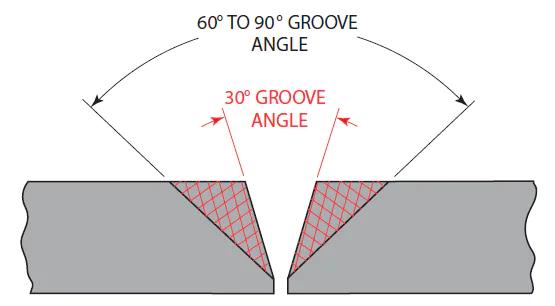
This reduced groove angle results in a smaller-sized weld and can save up to 50% of filler metal, as well as time and weld power.
4. Minimum Precleaning
In addition, FCAW requires minimal precleaning as the addition of deoxidizers and other fluxing agents allows for high-quality welds to be made on plates with mill scale and light surface oxides. This eliminates most of the precleaning required before GMAW can be performed.
5. All Position Welding
FCAW also offers the advantage of all-position welding, as small diameter electrode sizes in combination with special fluxes allow for excellent welds in all positions. The slags produced assist in supporting the weld metal, making the process easy to use.
6. High Quality
Since many codes allow for the use of this technique to make welds, the high quality of FCAW is also noteworthy. The high level of dependability required for welding on boilers, pressure vessels, and structural steel is provided by the addition of the flux.
7. Flexibility
The flexibility of FCAW also allows for changes in power settings to permit welding on thin-gauge sheet metals or thicker plates using the same electrode size, and multipass welds allow joining unlimited thickness metals.
8. Perfect Control
Finally, FCAW offers excellent control of the molten weld pool, as the surface appearance is smooth and uniform even with less operator skill. Visibility is improved by removing the nozzle when using self shielded rods.
Limitations of Flux-Core Welding
Flux Cored Arc Welding (FCAW) also has some limitations as well.
1. Confined to Ferrous Metals
One of the main limitations of FCAW is that it is mainly confined to ferrous metals, nickel-based alloys, and some hard facing electrodes.
While it can be used to weld low and medium-carbon steels, low-alloy steels, cast irons, and a limited number of stainless steels, it is not suitable for other types of metals.
2. High Cost of Filler Metals
Another limitation of FCAW is the cost of filler metals. The equipment and electrodes used for the FCAW process are more expensive than other welding methods. However, this cost can be quickly recovered through higher productivity.
3. Requires Slag Cleanup
Slag cleanup is also a limitation of FCAW. The removal of post-weld slag requires an additional production step, and the flux must be removed before the weldment is finished to prevent crevice corrosion. This can add extra time and labor to the welding process.
4. High Fume Rate
Similar to other welding techniques, FCAW produces more smoke and fumes. To handle the extra volume, a shop’s ventilation system may need to be upgraded. This might require additional funding and upkeep.
Materials Suitable for Flux-Core Welding
- Mild steel
- Low-alloy steel
- Stainless steel
- Nickel alloys
Equipment Needed For Flux-Core Welding
Equipment needed for flux core welding include
- Constant potential and constant voltage (CP, CV) power supply
- Flux-cored arc welding (FCA) gun (water-cooled or air-cooled)
- Fume extraction nozzle
- Vacuum system (for use with fume extraction nozzle)
- Pressure regulator (for use with water-cooled guns and direct building water supply)
- Check valves (for use with water-cooled guns and direct building water supply)
- Recirculation system with chemicals to prevent freezing aid in pump lubrication and prevent algae growth (for use with water-cooled guns)
Comparing MIG and Flux Core Welding
Similarities
Similarities between MIG welding and flux core welding:
- Both use a continuously fed wire as the electrode
- Both use a shielding gas to protect the weld pool
- Both can be automated with robotic systems
- Both are relatively fast and easy to use
Differences
- MIG welding is typically more expensive due to the complexity of the equipment
- MIG welding is more difficult to do outside because of the need for a shielding gas
- Flux core welding does not require a shielding gas
- Flux core welding produces more slag and requires more cleanup time
- MIG welding is more versatile in terms of thickness of metal it works on
- MIG welding eliminates almost all need for cleanup time and eliminates stub loss, as well as reducing number of starts and stops.
Comparing Advantages
| Criteria | MIG Welding | Flux Core Welding |
|---|---|---|
| Speed | ✔ | ❌ |
| Ease of Use | ✔ | ❌ |
| Range of Thicknesses | ✔ | ❌ |
| Cleanup Time | ✔ | ❌ |
| Number of Starts and Stops | ✔ | ❌ |
| Elimination of Stub Loss | ✔ | ❌ |
| Single Weld Large Passes | ✔ | ❌ |
| Equipment Cost | ❌ | ✔ |
| Welding Outside | ❌ | ✔ |
| Portability | ❌ | ✔ |
Comparing Key Features
| MIG Welding | Flux-Cored Welding |
|---|---|
| Uses electrode wire & shielding gas | Uses self-shielded wire |
| Can use different metal transfer methods | Typically uses spray arc transfer |
| Robotic welding possible | Not typically used for robotics |
| Faster | Slower |
| Easier, less cleanup | Harder, more cleanup |
| Can work on a wide range of thicknesses | Typically used for thicker materials |
| More expensive equipment, hard to use outside | Less expensive, can be used outside |
Which One is Better?
| Criteria | MIG Welding | Flux Core Welding |
|---|---|---|
| Thickness of Materials | Better | Not as good |
| Environment | Controlled (e.g. workshop or factory) | Outdoor or windy conditions |
| Speed | Faster | Slower |
| Ease of Use | Easier | Harder |
| Cleanup Time | Less | More |
| Equipment Cost | More Expensive | Less Expensive |
| Robotic Welding | Possible | Not typically used |
| Versatility | More versatile | Limited |
| Elimination of Stub Loss | ✔ | ❌ |
| Single Weld Large Passes | ✔ | ❌ |
| Number of Starts and Stops | ✔ | ❌ |
Based on all the above mentioned information, MIG welding is generally better for thicker materials and for use in a controlled environment, such as a workshop or factory. It is faster, easier to use, and produces less slag and cleanup time.
However, it is more expensive and not as well-suited for use outside or in windy conditions, due to the need for a shielding gas.
On the other hand, flux core welding is better for use outside or in windy conditions, as it does not require a shielding gas. It is also less expensive, but it is slower and requires more cleanup time.
Additionally, MIG welding is more versatile and eliminates the need for cleanup and stub loss, as well as reducing number of starts and stops. It is also possible to use robotic systems in MIG welding.
Final Thoughts
Both MIG and flux core welding are effective methods for welding various materials but they have their own unique advantages and disadvantages. MIG welding is a cleaner and more precise method but it requires a shielding gas whereas flux core welding does not.
However, flux core welding is better suited for outdoor use and for welding thicker materials. I hope the information provided in this blog was helpful in understanding the differences between these two welding methods and assisting you in making an informed decision on which method to use for your specific welding needs.
Informational
How to Weld If You Have Long Hair? Pro Welder’s Tips

Any welding operation that you perform puts you and anyone else in the area in danger of a number of different things. As a result, it is completely reasonable for you to be concerned about preventing your hair from becoming entangled in any welding equipment and posing a threat to your health. In this article, I will talk about how you can safely weld if you have long hair.
If you want to weld while having long hair, a French braid is the best option for keeping your hair together. This will help you in tying your hair and hold it together behind your neck. The French braid should keep the hair compact and close to your head’s shape, and it also allows you to wear a welding helmet. As a result, you will be able to wear full safety equipment.
When you are dealing with hot weld spatters, having long hair can present a particularly difficult challenge. Therefore, if you are interested in learning more about how you can safely weld with long hair, continue reading the rest of this article, where I will discuss the topic in greater detail and share some helpful hints.
How Your Long Hair Can be an Issue While Welding?
Welding procedures, as I indicated earlier, expose the operator as well as anybody else in the vicinity of the workplace to a wide variety of risks. A project involving welding presents a number of potential dangers and threats; it is important that you be aware of these issues in order to protect not only yourself but also others around you. Especially when dealing with spatters, it is easy for things to go wrong if you have long hair.
Before we look at all of the tips you may weld with long hair, we need to first understand the potential risks you run and everything that might go wrong. Long hair poses a unique set of challenges when it comes to welding. A few are mentioned below:
- Spatters are your hair’s worst enemy.
- UV rays can permanently damage your hair.
- With long hair, grinders can cause serious accidents.
Let’s look at these problems one by one:
1. Take Spatters Seriously
The spatter, sparks, and heat generated by the arc provides the greatest challenge throughout the welding process since they may travel up to 35 feet and enter any nearby place. You will want to provide enough protection for your long hair if you are going to be in an atmosphere like this.
Not just your hair, but everything else that might catch fire should be kept at least 35 feet away from the welding location. In addition, a fire extinguisher should never be far away. In the event that a fire breaks out.
2. UV Rays Can Damage Your Hair Permanently
Molten metals, welding arcs, and ultraviolet radiation will be present in the work environment while welding is being done. The interaction of all these factors puts you at an increased risk of serious burns. The actual welding arc may reach temperatures of up to 10,000 degrees Fahrenheit, making it one of the hottest processes possible.
And believe me when I say that you do not want that welding arc to get anywhere near your hair. Your hair will suffer a significant amount of damage as a result, and it is possible that it could even be burned.
3. Grinder Can Give You Nightmares
The usage of grinders is another factor that may create issues for your lengthy hair. Using grinders and welding go hand in hand when working with metals. Therefore, if you are a welder, you will most likely make extensive use of the grinder. And grinders are really your worst enemy when it comes to your long hair.
When you’re working, you can find yourself crouching over a grinder, which can cause serious accidents if you don’t protect your hair properly.
Tips from a Pro Welder to Protect Your Long Hair When Welding
Now you know what the most obvious dangers that you have when welding with long hair. The next step is to tell you how you can keep yourself safe from those dangers.
Here are a few of the tips that you can consider:
- Braid your hair while welding
- Put your hair in a tight knot behind your neck
- Consider buying a welding cap
- You can use a bandana too if you are a bandana lover
Let’s discuss these tips one by one:
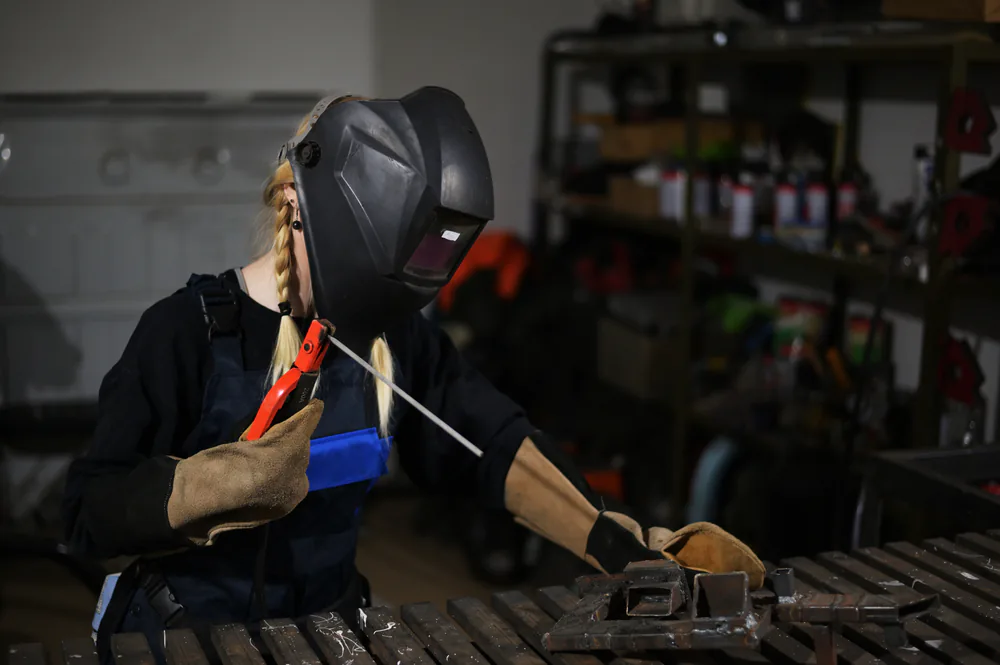
1. Braiding is the Best Option You Have
Welding hoods, helmets, or shields will provide the optimum amount of protection from any sparks, heat, UV rays, flash burns, or infrared light that may be present. They will protect not only your face and neck but also your eyes and hair. As a result, I feel that acquiring one is the best approach to protecting oneself.
Welding hoods are often made of cotton or leather and are rather light in weight and can go easily along with helmets. Make sure that whichever helmet you decide to purchase, is not too heavy and that it is comfortable to wear. It must also include a spatter barrier, the ability to be modified, a sensor bar, and the availability of replacement components.
2. You Can Simply Put Your Hair in a Tigh Knot
The most conventional and easiest technique for a welder operator to keep their long hair out of their face is to pull it back into a tight bun. Wrap an elastic band over your buns and secure them in place to prevent them from falling on your face.
If there are any unruly hairs, just use bobby pins to push them up and you should be OK. Anything that prevents your hair from falling on your face will suffice.
3. Consider Buying a Welding Cap
A welding cap is a good option if you want something that is both lightweight and comfortable. It must adequately shield your head from any hot metal, sparks, or splatters that may be present.
Not only they are effective in protecting your hair, but they are also made completely of cotton, making them incredibly breathable and also preventing sweat from pouring down your eyebrows while working.
4. Bandana is Another Option That You Can Use
Braids are not easy to create for everyone, and they may even be difficult to perform on a regular basis. If you don’t know how to braid my easiest suggestion would be to put a bandana over your head and tuck all of your hair within.
When welding, sparks will fly everywhere, and this will keep you safe. Make use of bobby pins or a bun to tuck in all of the ends. Bandanas aren’t my first choice for headgear. But it works. It’s a good option to have in case you don’t know how to braid your hair.
Few Other Safety Measures That You Need to Take
In addition to your hair, there are a few other parts of your body that need your attention. Some of these essential measures for ensuring your safety are listed below:
- Protect your eyes at all cost
- Always keep a fire extinguisher in your shop
- Wear protective clothing
- Make habit of using respirators
- Beware of leakages in your welding system
- Keep your welding space clean
Let’s discuss them one by one:
1. Protect your eyes at all cost
Be sure to always wear safety glasses in your workplace to protect your eyes from flying debris, which is often composed of metal. If you routinely do welding tasks, you will be exposed to a significant amount of flying debris.
You should make it a routine to put them on as soon as you come in the door; this will ensure that you are protected at all times.
2. Always keep a fire extinguisher in your shop
You shouldn’t be shocked if anything catches fire at some time during a welding operation because of all of the intense heat and sparks that are produced throughout the process. Because fires are a very real risk, you should always have an extinguisher on hand in case one breaks out.
3. Wear protective clothing
If you’ve ever imagined yourself beginning your first welding project in a pair of shorts, an old t-shirt, and a pair of flip-flops, you should rethink that idea. Wearing the necessary protective clothing at all times when welding is required if you wish to prevent injuries to your body, notably burns, that may be caused by the process.
4. Make habit of using respirators
You should always wear a respirator if you are going to be dealing with metals or any other materials that have the potential to emit harmful vapors.
Welding or cutting certain materials may produce a welding plume, which is a combination of hazardous gases, fumes, and smoke. This is not the type of thing you want to breathe in if you want to keep your lungs healthy and prevent respiratory issues.
5. Beware of leakages in your welding system
There is a good chance that you have pressurized containers in your welding shop that hold liquids or gases. Take extra precautions to check that none of those containers or the items that you are attaching to them have any leaks in them.
See my other article to know more about leakages and how to detect them.
6. Maintain your equipment
If you want to establish the safest possible working environment for your welding projects, you need to give your equipment a lot of TLC and make sure it’s in good operating order at all times. If your welding equipment and tools are in disrepair, an accident is almost waiting to happen every time you use them. However, the vast majority of incidents of this kind are avoidable if proper care is taken with the equipment.
Wrapping it Up
When it comes to welding, safety is the most important thing to keep in mind at all times. Because because welding involves a significant amount of fire and spatters, it is essential that you take a significant amount of precaution to protect your hair. I really hope that you’ll be able to keep your hair under control while welding thanks to the advice that’s been provided in this article.
Weld Types
Different Welding Methods: Applications of Each Method
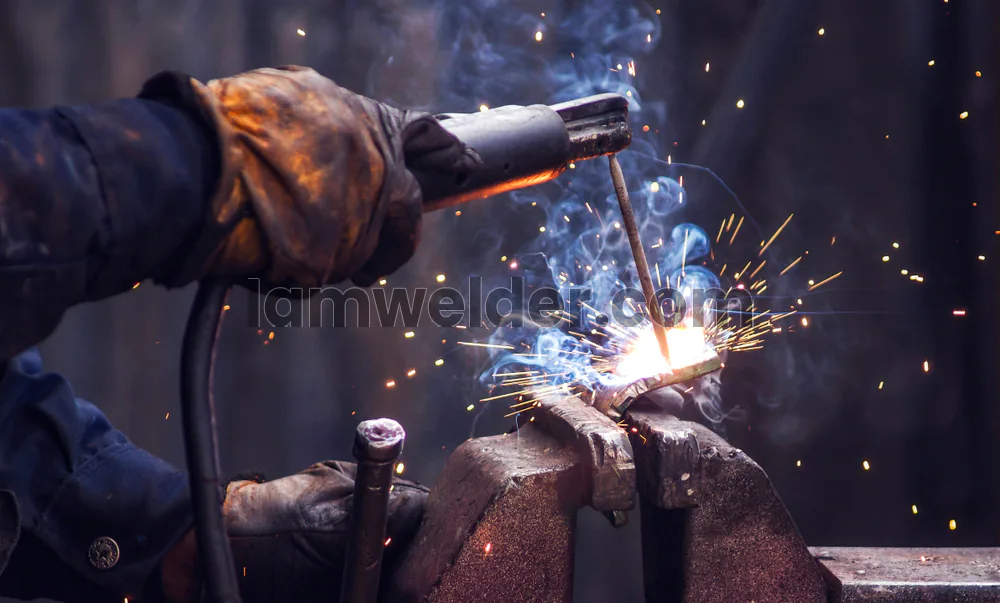
Welding is joining two pieces of metal together by melting and cooling them until they become one piece. Welding processes include:
- Oxyacetylene welding
- Shielded metal arc welding (Stick)
- Gas tungsten arc welding (TIG)
- Gas metal arc welding (MIG)
- Flux-cored arc welding
- Torch or oxyfuel brazing
Some methods employ both heat and pressure, while others employ only heat. Welding is commonly used to construct automobiles, airplanes, and buildings. Other metal-cutting methods, such as oxy-acetylene and plasma arc cutting, use heat or electricity to cut through metal.
1. Oxyacetylene welding
Oxyacetylene welding (OAW) is a method of joining two pieces of metal using heat generated by the combustion of oxygen and acetylene gas.
Torch brazing (TB) is similar, but the metal is not completely melted. Instead, a special alloy is melted and used to join the two metal pieces.
Oxyfuel gas cutting (OFC) is a method of cutting metal that uses the same tools and gases as OAW and TB.
To generate heat and bond the metal, all of these methods employ a torch and special gases. They are frequently used on small or thin metal pieces.
Applications:
- Welding and brazing thin or small pieces of metal
- Welding and brazing dissimilar metals
- Cutting and piercing metal
Situations to Avoid:
- Welding thick or heavy sections of metal
- Welding high alloy or stainless steel
- Welding in high wind or outdoor conditions (due to the open flame)
- Welding in confined spaces (due to the production of harmful gases)
2. Shielded metal arc welding (Stick)
Shielded metal arc welding, or SMAW, is a way of welding metal together using an electrode that is coated with a special kind of flux.
The electrode melts and becomes a part of the welded metal. To do SMAW welding, you need a transformer, two welding cables, a work clamp, and an electrode holder.
There are many different types of electrodes you can use for SMAW welding, so you can choose the one that is best for your project. With SMAW welding, you can join different types and thicknesses of metal using the same machine.
Applications:
- Welding thick or heavy sections of metal
- Welding in outdoor conditions
- Welding in dirty or contaminated environments
- Welding on dirty or painted surfaces
Situations to Avoid:
- Welding thin or small pieces of metal (more suited for TIG welding)
- Welding high alloy or stainless steel (can affect the quality of the weld)
- Welding in confined spaces (due to the production of harmful gases)
- Welding in the presence of high winds (due to the electric arc)
3. Gas tungsten arc welding
GTAW, or gas tungsten arc welding, is a method of joining metal using a tungsten electrode. The tungsten electrode generates an electric arc, which melts the metal being welded as well as the end of the filler metal, which is manually applied.
Shielding gas is emitted from the welding gun to protect the molten weld metal from dirt and other contaminants. A foot or thumb switch can be added to the GTAW equipment to help the welder better control the welding.
GTAW welding produces very clean, high-quality welds, but it is slower and requires more skill than other welding methods. It is particularly useful for joining metal alloys that can only be joined with GTAW.
Applications:
- Welding thin or small pieces of metal
- Welding high alloy or stainless steel
- Welding in outdoor conditions (with proper shielding gas)
- Welding materials with high levels of contaminants or impurities
- Welding in high-precision environments
Situations to Avoid:
- Welding thick or heavy sections of metal (more suited for MIG welding)
- Welding in high production environments (slower process)
- Welding in confined spaces (due to the production of harmful gases)
- Welding in the presence of high winds (due to the electric arc)
4. Gas metal arc welding (MIG)
Mig welding is a type of arc welding that uses a continuously supplied wire electrode and gas to weld metal together.
It is becoming more popular because it is easier to learn than other types of welding, like stick and tig welding, and it is faster because you don’t have to stop and change the electrode as often.
Mig welding also creates less slag and spatter, which makes it more enjoyable to use and easier to clean up.
However, MIG welding equipment is more expensive and the MIG gun, which is the portable part of the equipment, can be difficult to use in small spaces. Mig welding also requires a shielding gas to work, so it is not as good for outdoor use.
Applications:
- Welding thick or heavy sections of metal
- Welding high alloy or stainless steel
- Welding in high-production environments
- Welding in outdoor conditions (with proper shielding gas)
Situations to Avoid:
- Welding thin or small pieces of metal (more suited for TIG welding)
- Welding in confined spaces (due to the production of harmful gases)
- Welding in the presence of high winds (due to the electric arc)
- Welding materials with high levels of contaminants or impurities (can affect the quality of the weld)
5. Flux-cored arc welding
Flux-cored arc welding, or FCAW, is a method of joining metal using a special type of electrode wire known as a flux core wire.
The wire is fed from a spool continuously through the welding equipment and out of the gun. The welding current flows through the equipment, melting the wire and the base metal.
Some flux core wires generate their own shielding gas as they melt, while others require the use of additional shielding gas. As the wire melts, it produces a gaseous cloud that shields the weld surface and removes impurities from the molten metal.
After the weld is completed, a layer of slag must be removed from the weld’s top. Despite this additional step, FCAW is a popular welding technique because it produces high-quality welds quickly and is very versatile.
FCAW equipment is similar to that used in gas metal arc welding (GMAW), and both methods are semiautomatic, which means that the wire is fed automatically but the welder moves the gun manually. Welding supply stores and other retailers stock FCAW equipment and filler metals.
Applications:
- Welding thick or heavy sections of metal
- Welding in outdoor conditions (with proper shielding gas)
- Welding in high-production environments
- Welding in dirty or contaminated environments
Situations to Avoid:
- Welding thin or small pieces of metal (more suited for TIG welding)
- Welding high alloy or stainless steel (can affect the quality of the weld)
- Welding in confined spaces (due to the production of harmful gases)
- Welding in the presence of high winds (due to the electric arc)
Comparison Table:
| Welding Process | Applications | Situations to Avoid |
|---|---|---|
| Oxyacetylene welding | Welding and brazing thin or small pieces of metal; welding and brazing dissimilar metals; cutting and piercing metal | Welding thick or heavy sections of metal; welding high alloy or stainless steel; welding in high wind or outdoor conditions; welding in confined spaces |
| Shielded metal arc welding (Stick) | Welding thick or heavy sections of metal; welding in outdoor conditions; welding in dirty or contaminated environments; welding on dirty or painted surfaces | Welding thin or small pieces of metal; welding high alloy or stainless steel; welding in confined spaces; welding in the presence of high winds |
| Gas tungsten arc welding (TIG) | Welding thin or small pieces of metal; welding high alloy or stainless steel; welding in outdoor conditions (with proper shielding gas); welding materials with high levels of contaminants or impurities; welding in high-precision environments | Welding thick or heavy sections of metal; welding in high production environments; welding in confined spaces; welding in the presence of high winds |
| Gas metal arc welding (MIG) | Welding thick or heavy sections of metal; welding in high production environments; welding in outdoor conditions; welding on dirty or painted surfaces | Welding thin or small pieces of metal; welding high alloy or stainless steel; welding in confined spaces; welding in the presence of high winds |
| Flux-cored arc welding | Welding thick or heavy sections of metal; welding in high production environments; welding in outdoor conditions; welding on dirty or painted surfaces | Welding thin or small pieces of metal; welding high alloy or stainless steel; welding in confined spaces; welding in the presence of high winds |














